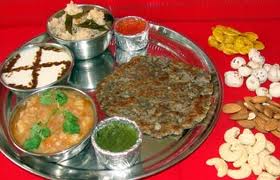Navratri Fast Procedure
 Navratri Fast Procedure
Navratri Fast Procedure
On the festive occasion of Navratri, fast is observed by people for seven or eight days, depending upon when they want to conduct the Kanchika Pujan (when young girls are worshipped). The devotees, who have observed fast, would get up early in the morning, take bath and offer prayers to the deity. People follow a specific diet for Navratr. Most people nowadays perform partial fasting. They would abstain from non-vegetarian food, alcohol and those dishes that are made of common salt or any kind of spice. Singhare ka atta or kuttu ka atta is used to prepare rotis or puris, for the fast.
One may drink beverages like tea, coffee and milk, on Navratri. Dishes made of sago and potato is generally consumed by the people, when they observe fast on Navratri. Sendha namak is used instead of common salt, for cooking on the festival. All fruits and foodstuff made of fruits are eaten during the seven days. Nowadays, ready-to-eat snacks are available in the stores, especially prepared for Navratri. In addition to this, certain restaurants in the northern parts of India would offer special menu for the people, who have observed fast on Navratri.
After seven days of fasting, people would break their fast on the eighth day - Ashtami - by worshipping young girls. The ritual of offering prasad to the young girls is called Kanchika Pujan. As per the tradition, puris, halwa (sweet dish made of suji) and Bengal gram curry are served to the young girls, called upon by the people who have observed fast. After seeking the blessings of the young girls (kanchikayen), the devotees would break their fast by consuming the prasad (puri, halwa and sabzi) that they have prepared for them. While this is the tradition followed by majority of people, Navratri fast is also broken on ninth day (Navami), wherein the fast is observed until Ashtami. The same procedure is followed in that case as well.
Learn Astrology
Yog in Astrology
Marriage and Astrology
Career and Astrology
Lal Kitab
Articles
Vedic Rituals
Sikh Gurus
Interesting Stories
Vastu
Remedies
Chogadhia
Hora
Navratri
Dasmahavidya
Stories
Keep Smiling
Geeta Gyan
Temples in India
Temples in USA
Temples in UK
Temples in France
Essays
Recipes
Horoscope
Kavach
